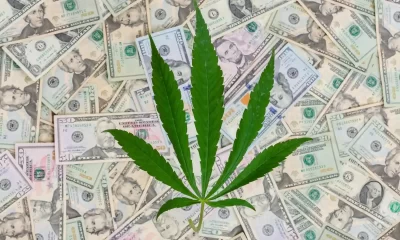Lifestyle
Who Buys the Most Weed in America? Gen Z Passes the Baby Boomers for Biggest Cannabis Customers!

Gen Z just became the $1 cannabis consumer group in the world!
While a larger percentage of Generation Z aren’t old enough to purchase cannabis, the small percentage can have proven to be huge consumers. And now with 420 becoming one of the biggest ceremonies across the United States, cannabis consumption and sales have increased with Gen Z’s huge consumers.
Over the years, Gen Z consumption has increased especially as cannabis legalization across the United States continues to gain ground. Over the last 5 years, Gen Z cannabis consumption has increased significantly with data from Headset, an analytics company backing up the claims.
Gen Z Cannabis Consumption in 2021
According to data provided by Headset, an analytics company, the first half of 2021 saw Gen Z overtake Baby Boomers in terms of overall marijuana sales for the very first time across four legal states. Looking at the current trend, Cooper Ashley, a senior analyst at Headset affirmed that Gen Z in the next 10 to 15 years will become the largest generation in terms of overall cannabis sales.
Only a small percentage of Gen Z, roughly 9 to 24 years old, are eligible to legally buy cannabis. Even that, the age group now accounts for 12.7% of cannabis sales in Colorado, California, Washington, and Nevada. This data collected in the first of 2021 shows an increase of 4% compared to 2020.
In the same year, Baby boomers accounted for 12.1% of the overall sale which was a decrease from 13.9% in 2021. This means Gen Z for the very first time surpassed Baby Boomers in terms of overall cannabis sales. Even the almighty millennials lost market shares to Gen Z as they account for 51.8% of cannabis sales in 2021. This represents a decrease of 0.2% compared to 2020.
Now, as it currently stands, store sales of cannabis have increased by 148% in 2022 according to the data provided by Headset. And what age group is buying all the cannabis products? Gen Z!, who is now legally old enough to buy cannabis.
A shifting demographic creates a fresh marketplace
As the cannabis industry continues to evolve and grow, so does its target market, from one generation to the next. As Gen Z comes of age, they are rapidly accepting cannabis, making new trends while the industry continues to change to meet demands.To this end, Headset decided to look into Gen Z and how they purchased cannabis on 420 this year. The analytic company looked into the purchases from basket sizes to product preferences. According to the Headset report, Gen Z cannabis consumers are the most involved, expanding their average daily spending on cannabis purchases.
While Gen Z Women purchase 25% more cannabis products, Gen Z men purchase 35% more compared to the previous week.
Gen Z’s Product Preference
On 420, beverages had the highest increase in sales, accounting for a 5 times increase compared to a usual day. Pre-rolls and edibles also showed great numbers on the said day. If this data directly translates to market direction, then vape pens are getting outdated.
Or it could just translate to Gen Z customers who were looking to buy cannabis supplies for the celebratory parties instead of their usual supply. Nonetheless, this data available could help retailers draw up the group as repeat customers. Maybe now is the right time to stock up on single-served items and more edibles as Gen Z continues to age into cannabis use for recreational purposes.
Total Cannabis sales among Gen Z
Total cannabis sales among Gen Z surged by 127% with a total of $370 million in 2018 to $850 million in 2020. When compared to that of millennials, that is about three times more than cannabis sales among millennials. According to the data provided, millennials recorded a surge in cannabis sales of 46% seeing an increase from $3 billion in 2019 to over $4 billion in 2020.
Ashley credited Gen Z’s remarkable growth to the fact that not all in the age group are eligible to purchase cannabis. Therefore, as more young adults in Gen Z come of age (21 years), sales will continue to increase. Ashley affirmed that with more Gen Z coming of age every single day, legal cannabis sales for the age group will continue to increase. With this trend, Gen Z will eventually become one of the most vital demographic groups in the industry.
The report also indicated that the increase in cannabis sales by age group also seems to be declining with older generations. Sales of cannabis among Gen X increased by 29% from $1.6 billion to 2 billion from 2019 to 2020. On the other hand, sales of cannabis among Baby boomers surged by 5% increasing from $970 million to about $1 billion from 2019 to 2020.
The Silent Generation (aged 75 to 95 years of age) was the only group that witnessed a massive decline in cannabis sales. The age group witnesses a decline of 18% from $50 million to about $40 million. This decline in sales among older generations could be a result of several factors, especially during the Covid pandemic. During this period, lots of consumers stayed at home to curb viral exposure.
Consumption Habits of Gen Z
The Headset report indicated that cannabis may have become an inherent culture for Gen Z compared to older generations who may see cannabis as a splurge. Meanwhile, as cannabis sales among Gen Z increase, interest in alcohol among young adults is declining.
It is said that this consumption habit among Gen Z could be a result of the impact of their distinct qualities. One thing about Gen Z is that they were born in an era when cannabis legalization took off. Medical use of cannabis was legalized in California in 1996. Oregon, Alaska, and Washington took the same step in 1998. Today, 18 states have legalized cannabis for recreational use, and 36 legalized states for medical cannabis use.
With so much cannabis legalization happening through Gen Z’s era, cannabis perception has changed and the generation seems to be more accepting of it. Now Gen Z sees cannabis as equal to alcohol and just another option of an intoxicating substance.
Conclusion
Certainly, it may be too early to make conclusions on Gen Z’s product preferences and cannabis sales. However, if the present growth trend proves to be a solid pointer towards the market direction, Gen Z will be a vital consumer section for the cannabis industry shortly.
Business
Alabama to make another attempt Dec. 1 to award medical cannabis licenses

Alabama regulators are targeting Dec. 1 to award the first batch of medical cannabis business licenses after the agency’s first two attempts were scrapped because of scoring errors and litigation.
The first licenses will be awarded to individual cultivators, delivery providers, processors, dispensaries and state testing labs, according to the Alabama Medical Cannabis Commission (AMCC).
Then, on Dec. 12, the AMCC will award licenses for vertically integrated operations, a designation set primarily for multistate operators.
Licenses are expected to be handed out 28 days after they have been awarded, so MMJ production could begin in early January, according to the Alabama Daily News.
That means MMJ products could be available for patients around early March, an AMCC spokesperson told the media outlet.
Regulators initially awarded 21 business licenses in June, only to void them after applicants alleged inconsistencies with how the applications were scored.
Then, in August, the state awarded 24 different licenses – 19 went to June recipients – only to reverse themselves again and scratch those licenses after spurned applicants filed lawsuits.
A state judge dismissed a lawsuit filed by Chicago-based MSO Verano Holdings Corp., but another lawsuit is pending.
Source: https://mjbizdaily.com/alabama-plans-to-award-medical-cannabis-licenses-dec-1/
Business
Pot Odor Does Not Justify Probable Cause for Vehicle Searches, Minnesota Court Affirms

The Minnesota Supreme Court affirmed that cannabis odor does not constitute probable cause to search a vehicle.
If Minnesota police search a vehicle solely based upon the smell of pot, they can’t justify searching a vehicle, even if there is evidence found of other alleged crimes. Even after appealing a lower court decision to suppress the evidence—twice—the Minnesota Supreme Court agreed, and the dismissal of his charges stands.
In a ruling filed regarding a case the State of Minnesota Court of Appeals on Sept. 13, the Minnesota Supreme Court affirmed that cannabis odor does not constitute probable cause to search a vehicle.
The case has been ongoing for two years. On July 5, 2021, just before 10 p.m., a Litchfield police officer stopped a car for an obscure local law: the light bar mounted on the vehicle’s grill had more auxiliary driving lights than are permitted under Minnesota law. The officer asked the driver, Adam Lloyd Torgerson, for his license and registration. Torgerson, his wife, and his child were present in the vehicle. The officer stated that he smelled pot and asked Torgerson if there was any reason for the odor, which he initially denied. But cops found a lot more than just pot.
A backup officer was called in. The couple denied possessing any pot, but Torgerson admitted to smoking weed in the past. The second officer stated that the weed odor gave them probable cause to search the vehicle and ordered them to exit the vehicle. The first officer searched the vehicle and found a film canister, three pipes, and a small plastic bag in the center console. The plastic bag contained a white powder and the film canister contained meth, which was confirmed in a field test.
Torgenson was charged with possession of meth pipe in the presence of a minor and fifth-degree possession of a controlled substance after the unwarranted search of Torgerson’s vehicle.
Police Aren’t Allowed to Do That, Multiple Courts Rule
But the search had one major problem—cops weren’t searching for a meth pipe. They only searched his car because they could smell pot, and the meth and paraphernalia were a surprise for everyone. Still, they had no grounds to search the vehicle. The man’s charges were later dismissed after the district court determined the odor of cannabis alone was insufficient basis for probable cause to search the vehicle, regardless of whatever other drug paraphernalia they found.
The state appealed the case, but the Minnesota Court of Appeals affirmed the district court’s decision. The case was appealed a second time, this time to the Minnesota Supreme Court, which agreed with the lower court’s ruling.
“This search was justified only by the odor of marijuana emanating from the vehicle,” the Minnesota Supreme Court decision reads. “Torgerson moved to suppress the evidence found during the search, arguing that the odor of marijuana, alone, is insufficient to create the requisite probable cause to search a vehicle under the automobile exception to the warrant requirement. The district court granted Torgerson’s motion, suppressed the evidence, and dismissed the complaint. The State appealed. The court of appeals affirmed the district court’s suppression order. Because we conclude that the odor of marijuana emanating from a vehicle, alone, is insufficient to create the requisite probable cause to search a vehicle under the automobile exception to the warrant requirement, we affirm.”
It amounts to basic human rights that apply—regardless of whether or not a person is addicted to drugs.
Other States do Precisely the Same Regarding Pot Odor as Probably Cause
An Illinois judge ruled in 2021 that the odor of cannabis is not sufficient grounds for police to search a vehicle without a warrant during a traffic stop.
Daniel J. Dalton, Associate Judge of the 14th Judicial Circuit, issued a ruling in response to a motion to suppress evidence in the case of Vincent Molina, a medical cannabis patient arrested for cannabis possession last year.
In that case, Molina was arrested despite the decriminalization of small amounts of cannabis in Illinois in 2019 with the passage of the Illinois Cannabis Regulation and Tax Act.
In some states, the issue of probable cause and cannabis was defined through bills.
Last April, the Maryland House of Delegates approved a bill that reduces the penalties for public cannabis consumption and bars police from using the odor of cannabis as the basis for the search of an individual or auto. Under Maryland’s House Bill 1071, law enforcement officers would be prohibited from using the odor of raw or burnt cannabis as probable cause to search a person or vehicle.
The rulings represent the rights of citizens when they are pulled over by police, even if there are hard drugs involved.
Business
Can Cannabis Help Seasonal Depression

Ultimately, seasonal affective disorder can set in as quickly and seamlessly as the fall foliage on the trees outside.
The weather and foliage on the trees aren’t the only things that are changing around this time of year. As the sun starts to set earlier and earlier, peoples moods can be affected by the decrease in sunlight. This is often known as seasonal affective disorder (SAD), and it can make the winter months miserable for lots of people. Can cannabis help seasonal depression?
Fortunately for those that do suffer from SAD, there are numerous remedies that can make this time of year more bearable. Exercise, vitamin supplements and even marijuana can have an enormous impact on fighting against the disorder. While there are resources for offsetting the disorder, getting a full understanding of the problem is paramount in being able to overcome it.

Seasonal Affective Disorder Symptoms
One of the most crucial steps in combating SAD is properly identifying its symptoms. Some of those symptoms include:
- Anxiety
- Social withdrawal
- Sleepiness and fatigue
- Weight gain
- Suicidal thoughts
- And several others
Those who are suffering from any of these symptoms should refrain from self-diagnosis and seek professional assistance. That professional assistance could lead to more resources to fight the disorder such as an antidepressant prescription.
How Common is Seasonal Affective Disorder?
In recent years, more and more people who suffer from seasonal affective disorder have begun opening up about their struggles. An estimated 10 million Americans are said to be currently dealing from SAD. Additional research shows women are four times more likely to be diagnosed with the disorder than men. SAD also appears to be more prevalent among people with pre-existing mental health conditions like bipolar disorder.
The number of people across the globe who suffer from seasonal depression is slightly lower than that of the United States. Only about 1-2% of the global population is said to suffer from seasonal depression while about 5% of the U.S population suffers from SAD.

How to Fight Seasonal Affective Disorder
There are a number of proven ways to offset some of the sadness that comes with the changing of the seasons. For example, cannabis contains cannabinoids that can have a positive impact on mood, while potentially increasing serotonin levels. When it comes to decreasing anxiety levels, that’s where CBD comes into play. By working with our body’s endocannabinoid system, CBD has been seen as instrumental in boosting dopamine levels.
Aside from cannabis, there are a handful of other at-home methods that can help alleviate the symptoms of seasonal affective disorder. Spending more time with friends, family and loved ones can be highly effective in offsetting some SAD symptoms. The same can be said for making an effort to get lots of sunlight and getting regular exercise.
Ultimately, seasonal affective disorder can set in as quickly and seamlessly as the fall foliage on the trees outside. Knowing that you aren’t alone, and having the best practices for fighting it, can make the fall and winter months better than you could have ever imagined.
Source: https://thefreshtoast.com/medical-marijuana/can-cannabis-help-seasonal-depression/
-

 Business2 years ago
Business2 years agoPot Odor Does Not Justify Probable Cause for Vehicle Searches, Minnesota Court Affirms
-

 Business2 years ago
Business2 years agoNew Mexico cannabis operator fined, loses license for alleged BioTrack fraud
-

 Business2 years ago
Business2 years agoAlabama to make another attempt Dec. 1 to award medical cannabis licenses
-

 Business2 years ago
Business2 years agoWashington State Pays Out $9.4 Million in Refunds Relating to Drug Convictions
-

 Business2 years ago
Business2 years agoMarijuana companies suing US attorney general in federal prohibition challenge
-

 Business2 years ago
Business2 years agoLegal Marijuana Handed A Nothing Burger From NY State
-

 Business2 years ago
Business2 years agoCan Cannabis Help Seasonal Depression
-

 Blogs2 years ago
Blogs2 years agoCannabis Art Is Flourishing On Etsy









